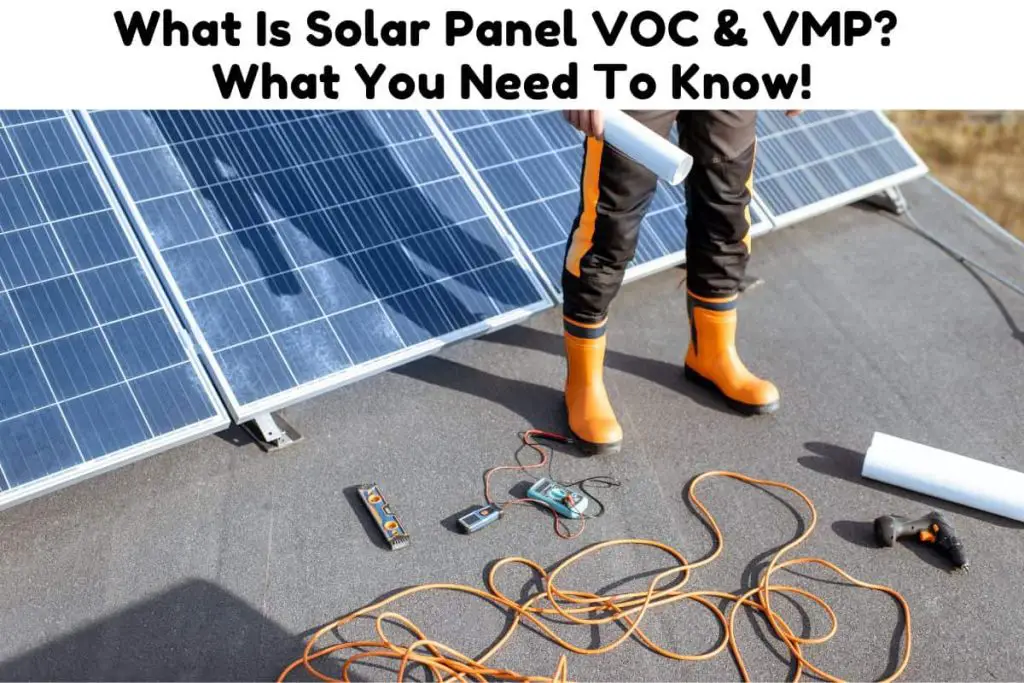Photovoltaic solar panels are the best way to capture the massive amount of energy the sun produces. The sun generates in an hour more than 43 times the energy we need to keep the U.S running for an entire year! But how much of the energy produced in a solar panel finds its way to your laptop or TV as electricity?
The back sheet of a solar panel always has the technical specifications of that solar panel printed on it. They give you information on the solar panel open-circuit voltage (VOC), the maximum power voltage (VMP), efficiency, and a few other important details. But what do they all mean?
What is solar panel VOC and why is it even important for you to know? In this article, we will give you a simple explanation of what the specifications printed on your solar panel mean. By the time you reach the end of this article, you will be an expert at reading solar specs and explaining them to anyone thinking of getting solar panels.

What are VMP and VOC in solar panels?
The VMP and VOC are specifications on a solar panel. The VOC is the open-circuit voltage which refers to how many volts the panel produces with no load on it. The VMP refers to the solar panel’s peak power voltage.VOC and VMP are two of several important specifications that help you understand how much power your solar panel will produce.
On a side note! If you’re in need of a reliable and high-performance portable solar panel, We strongly recommend the Jackery SolarSaga 100W Portable Solar Panel (Amazon Link).
With a high conversion efficiency and foldable design, this solar panel is easy to transport and set up, making it perfect for outdoor activities like camping, hiking, and RV trips.

The US solar cell technology used in this panel ensures that you get the most efficient and reliable solar charging possible.
There is also a 60W option that is more affordable (Amazon Link)
Depending on the manufacturer, a solar panel will have a few or all of the following specs also given:
- Maximum efficiency
- Maximum power (PMAX)
- Maximum power voltage (VMP)
- Maximum power current (IMP)
- Open circuit voltage (VOC)
- Short circuit current (ISC)
- Standard Test Conditions (STC)
- Nominal voltage
VOC and VMP deal with the voltage of the solar panel. Let’s look at each in detail.
Solar panel open-circuit voltage (VOC)
The open-circuit voltage is the voltage produced by the solar panel when there is nothing connected to it. It is the maximum voltage of a solar panel without current flowing. Depending on the nominal voltage of your solar panel, the open-circuit voltage will range from 21 to 42V. (Source)
| Nominal voltage | VOC | VMP |
| 12V | 21 | 17 |
| 18V | 30/33 | 24/26 |
| 20V | 36 | 29 |
| 24V | 42 | 35 |
Solar panel VOC is important for designing your system. It is what you will use to work out how many solar panels you can wire in series that will feed into your inverter or charge controller. It is for this reason that VOC is usually tested when the solar panel is brand new.
On a side note, check out you can Use Solid Wire For Solar Panels? (A Brief Solar Panel Wire Guide) & Can You Use 24V & 36V Solar Panels To Charge A 12V Battery? Should You!
Solar panel maximum power voltage (VMP)
Maximum power voltage is the voltage of a solar panel when it is connected to a load and operating at its peak performance. It is the maximum voltage with current flowing. In that sense, it is the direct opposite of VOC.
VMP is a little harder to measure than VOP and in most cases will not be as accurate a number. The load on the system will typically reduce the VMP which will throw off any measures or calculations.
Other specifications
The other values include the nominal voltage, standard test conditions (STC), short circuit current (ISC), the maximum power (Pmax), maximum power current (IMP), and of course the maximum efficiency. As they influence VOC and VMP we will touch on them briefly.
NOMINAL VOLTAGE is used for categorization. It is a bygone relic from days when the voltage on your solar panel had to match the voltage on your batteries. Nowadays it is not as important since we have charge controllers that can step down or up the voltages in a solar panel so it matches with the battery.
STANDARD TEST CONDITIONS (STC) are criteria solar panels need to meet. These include voltage and current changes based on temperature and light intensity for example. Solar panels are tested to ensure they meet a minimum standard of performance under those and other criteria.
SHORT CIRCUIT CURRENT (ISC) is the maximum current (in amps) produced without a load connected. It is when the plus and minus terminals are connected to each other which allows current to flow within the module.
MAXIMUM POWER (PMAX) is the point at which the voltage (VMP) and current (IMP) combine to produce the most watts. It is worked out as VMP*IMP=Watts.
MAXIMUM POWER CURRENT (IMP) is the current at maximum power.
MAXIMUM EFFICIENCY is the one most people are familiar with. It is a measure of how efficiently the solar panel converts sunlight to electricity. The efficiency of a solar panel depends largely on what type it is. Monocrystalline is the most efficient solar panel followed by a polycrystalline and thin film.
How Do You Calculate the Voc of A Solar Panel?
The VOC of a solar panel is calculated using the temperature coefficient of the solar panel. Using the temperature coefficient adjusts for the variances in voltage that are caused by the variances in temperature.
There is an inverse relationship between VOC and temperature. The lower the temperature, the higher the VOC, and vice versa. (Source)
What is VOC max solar?
VOC max solar is the maximum open-circuit voltage of a string of solar panels wired together in series. You can use it to work out the size of the inverter you need.
Also, check out our post ” Can I Use Solar Panels Without An Inverter? Tips & Tricks“
What Does Voc Mean on A Charge Controller?
VOC on a charge controller is the minimum and maximum open-circuit voltage you will use for the charge controller. Generally, you should not exceed either the VOC or the VMP for a charge controller as this can potentially damage the charge controller.
This is why it is important to have a correct value for the voltages coming out of your solar panel. If the voltages exceed what the charge controller can handle this will could result in damage to the controller.
Some solar chargers are better equipped to handle the large VOC fluctuations that can occur on very hot or cold days. Maximum Power Point Tracking charge controllers are better in this respect compared to Pulse Width Modulator controllers.
One workaround is to oversize the charge controller to compensate for any large variations in VOC or VMP.
